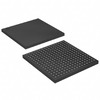Manufacturer Part Number
5CEBA2U15C7N
Manufacturer
Intel
Introduction
The Intel 5CEBA2U15C7N is part of the Cyclone® V E series, designed for embedded applications requiring high-performance, low-power FPGA solutions.
Product Features and Performance
Utilizes the 28nm low-power process technology
Incorporates 25,000 logic elements/cells for complex digital functions
Features 9,434 Logic Array Blocks (LABs)/Configurable Logic Blocks (CLBs)
Offers 1,994,294 total RAM bits for extensive data storage
Provides 176 flexible input/output pins for wide connectivity options
Supports a supply voltage range of 1.07V~1.13V, optimizing power efficiency
Operates reliably within a temperature range of 0°C to 85°C
Product Advantages
High integration and performance suitable for demanding applications
Low power consumption enhances system efficiency and reduces thermal footprint
Flexibility in design with significant logic resources and memory capacity
Broad I/O connectivity supports various peripherals and interfaces
Key Technical Parameters
Number of LABs/CLBs: 9434
Number of Logic Elements/Cells: 25000
Total RAM Bits: 2002944
Number of I/O: 176
Voltage Supply: 1.07V ~ 1.13V
Operating Temperature: 0°C ~ 85°C
Quality and Safety Features
Designed and tested to meet Intel's rigorous quality standards
Features robust electrostatic discharge (ESD) protection mechanisms
Includes built-in temperature sensors for thermal monitoring
Compatibility
Compatible with a wide range of standard hardware interfaces and protocols
Easy integration with Intel's development tools and software ecosystem
Application Areas
Ideal for use in automotive, industrial, communication, and defense applications
Suits high-speed data processing, control systems, and IoT devices
Product Lifecycle
This product remains active, with no current indication of discontinuation.
Intel typically offers extensive support for product transitions and upgrades.
Several Key Reasons to Choose This Product
Direct access to Intel's advanced FPGA technology and support ecosystem
Balances performance and power efficiency, making it ideal for power-sensitive applications
Rich set of features and high flexibility for future-proofing complex designs
Extensive development tools and resources simplify the design process
Longevity of product lifecycle ensures stability and support for future developments




 5CEBA4C15C8NAltera (Intel)
5CEBA4C15C8NAltera (Intel)